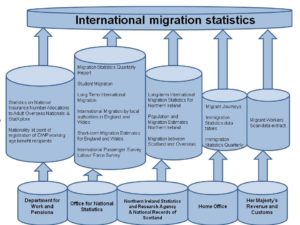More than the sum of the parts: the role of families of statistics in supporting insight and innovation
In last year’s Code of Practice stocktake, we outlined the idea of ‘families’ of statistics. In this blog, I want to bring out some of the ways that ‘families’ support the way we are thinking about statistics as an essential public asset.
What do we mean by families of statistics?
The traditional way of publishing statistics reflects the way that the underlying data are collected – with each source being published as soon as the statistics are deemed ready. This gets new information into the public domain quickly, supporting decision makers and democratic debate.
But it can lead to the piecemeal release of statistics, a deluge of information that can be hard to interpret coherently. It can make it hard for the user to take a step back and ask “what is this new information telling me?”
Let me illustrate what we mean by ‘families’ of statistics through two examples – international migration, and roads.
As the diagram below shows, statistics about different aspects of international migration are drawn from a range of surveys and administrative sources and produced by several organisations across the UK. Each set of statistics is useful in its own right but the value of this ‘family’ is maximised when the statistics are brought together so that they shed light on the questions that are important to society. Indeed, ONS does bring several of the statistical sets together, in its Migration Statistics Quarterly Report.
And again, many organisations produce statistics, numerical information and research reports and other analytical pieces about different aspects of roads (captured in the diagram below). Some of these include organisations which do not produce official statistics (and who might be interested in voluntary compliance), which reinforces the idea that families are not just about official statistics but about numerical information on a particular topic.
How do families fit with the refreshed Code?
The draft Code of Practice for Statistics, about which we are currently consulting, is structured around three pillars – Trustworthiness, Quality and Value. Among the principles that support Value are that statistics should be insightful – helping to clearly answer society’s important questions – and that statistical production should be innovative – so that the statistics remain relevant in a changing world.
The idea of families of statistics plays right into this. In terms of insight, approaching the production and presentation of statistics through the strategic lens of a family helps to enable a complete picture of the statistical topic to be provided, and encourages producers of statistics to work collaboratively with producers of related statistics and topic experts (Principle V2, practice 3, draft Code of Practice for Statistics ). And it supports the explanation of the coherence of the statistics with other related data sources and statistics, and signposting to the related statistics (Principle V2, practice 4, draft Code of Practice for Statistics ). In terms of innovation, the family approach helps producers to seek out new partnerships which could improve the value of their statistics (Principle V4, practice 1, draft Code of Practice for Statistics) and to explore the potential of new and existing data sources (Principle V4, practice 2(i), draft Code of Practice for Statistics).
What will OSR do about families?
For us, the family approach will support the way we are increasingly looking at issues systemically: reviewing and reporting on issues and opportunities that cut across the statistical system. As part of our increasing focus on themes, as described in our Business Plan, we will work with statistical Heads of Profession (HOPs) across government to support their development of families of statistics in the areas for which they are responsible, working with users of the statistics.
What should statistical producers do next?
I mentioned above that we will work with statistical HOPs across government to support their development of families of statistics. In preparation for this it would be really helpful if they could:
- Start to think about how, in practical terms, families could benefit them and improve TQV in their outputs, and how they might start to use families in their statistical planning, and their production and dissemination work. This might be a helpful starting point for discussion:
trustworthy
- leadership and coordination across the system, including in those cases where organisations’ responsibilities relate only to part of the statistical value chain, such as NHS Digital which specialises in ‘data’.
- taking account of needs of wide range of decision-makers not just Government
- orderly release
quality
- fully exploiting administrative data from various sources
- clarifying responsibility for fixing data problems
- standards for management information
value
- easier access to statistics e.g. for researchers
- protecting insight – complement latest snapshot data
- Consider how broadly to define families. What level of granularity is most appropriate?
Any questions?
If you have any questions about families of statistic or would like an accessible version of the diagrams, please contact me on regulation@statistics.gov.uk
More generally, the values of OSR include being: externally engaged and connected; enquiring and open-minded; and inclusive and listening to others – we want to listen and learn. So, if this blog stimulates any other thoughts, please let me know.


